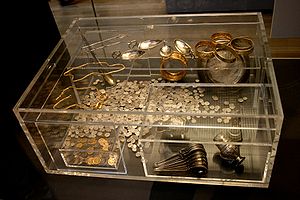Hoxne Hoard

Display case reconstructing the arrangement of the hoard treasure when excavated.
|
|
| Material | Gold, silver, bronze, iron, and organic material |
|---|---|
| Created | 4th or 5th century |
| Period/culture | Roman Empire |
| Discovered | Hoxne, Suffolk, by Eric Lawes on 16 November 1992 |
| Present location | Room 49, British Museum, London |
Coordinates: 52°20′N 1°11′E / 52.333°N 1.183°E
The Hoxne Hoard (/ˈhɒksən/ HOK-sən) is the largest hoard of late Roman silver and gold discovered in Britain, and the largest collection of gold and silver coins of the fourth and fifth century found anywhere within the Roman Empire. Found by Eric Lawes, a metal detectorist in the village of Hoxne in Suffolk, England, on 16 November 1992, the hoard consists of 14,865 Roman gold, silver and bronze coins from the late fourth and early fifth centuries, and approximately 200 items of silver tableware and gold jewellery. The objects are now in the British Museum in London, where the most important pieces and a selection of the rest are on permanent display. In 1993, the Treasure Valuation Committee valued the hoard at £1.75 million (today £3.21 million).
...
Wikipedia
